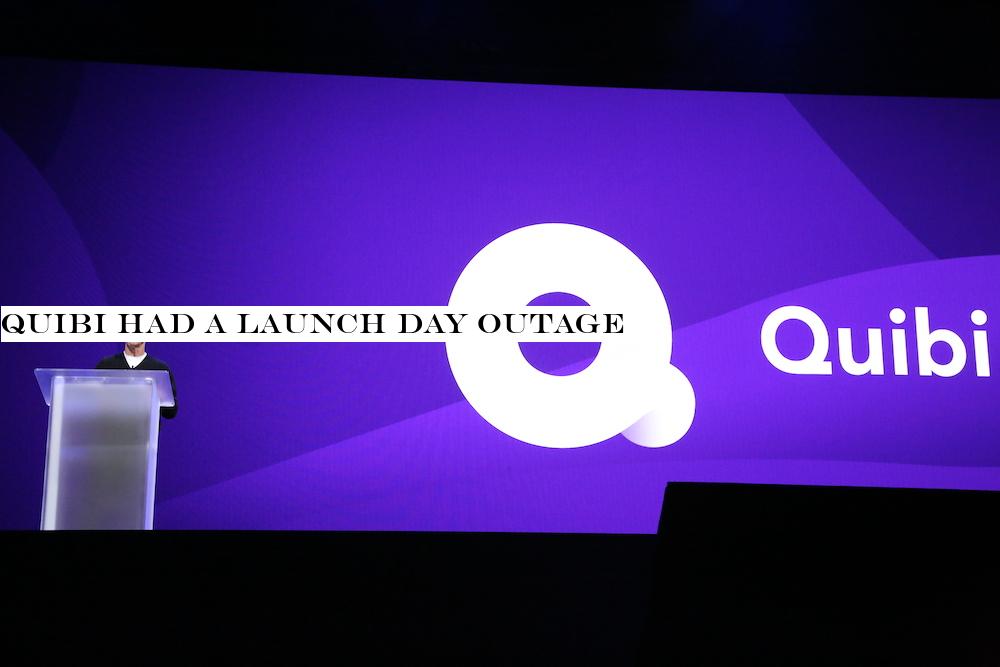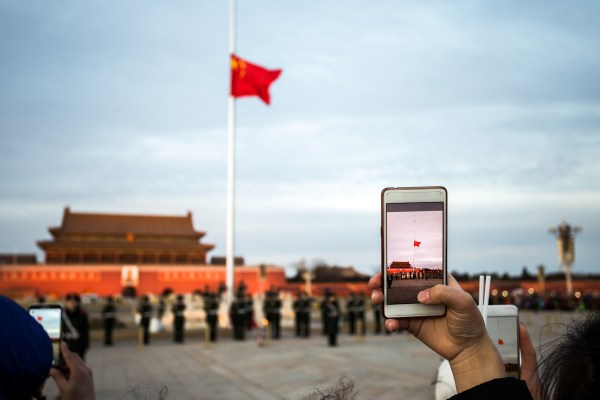Music
Trailers
DailyVideos
India
Pakistan
Afghanistan
Bangladesh
Srilanka
Nepal
Thailand
StockMarket
Business
Technology
Startup
Trending Videos
Coupons
Football
Search
Download App in Playstore
Download App
Best Collections
Technology

Looks like things haven&t gone completely smoothly with Quibi‘s launch.
The issue appears to have been resolved, but the Quibi customer support account tweeted this afternoon that &some users may be experiencing problems with the Quibi app,& only to add an hour later that &Users should once again be able to use the Quibi app normally. Thank you for your patience.&
Itnot clear how widespread the outage was, but according to The Verge, one staffer saw an error screen and was unable to browse the app, while another was unable to create an account. The app seems to be working normally as I write this shortly after 4pm Eastern.
If nothing else, ita reminder that reliably delivering streaming video is hard, even for a startup thatraised $1.75 billion. Heck, even Disney experienced widespread streaming issues when it launched Disney+ in November. (It all worked out fine.)
A quick catch-up for those of you still wondering what Quibi even is: Ita short-form video service founded by Hollywood executive Jeffrey Katzenberg and led by CEO Meg Whitman (previously CEO of Hewlett Packard Enterprise and eBay).
The app islaunching with nearly 50 shows today, all of them created specifically for mobile, with episodes that are less than 10 minutes long. After a 90-day free trial, it&ll cost you $4.99 with ads or $7.99 per month without ads.
- Details
- Category: Technology Today
Read more: Quibi had a launch day blackout
Write comment (93 Comments)TechCrunch confirmed today that BounceX (the firm is rebranding this year) has executed layoffs and salary cuts in the wake of recent COVID-19-led economic disruptions.
Many startups are undergoing staff cuts as the domestic and global economies slow, making individual reductions less newsworthy as the layoff tally rises. However, as BounceX is a company we&ve recently highlighted for its growth and capital efficiency, its own cuts are worth noting.
Reductions
TechCrunch was tipped concerning the BounceX staff cuts and salary reductions earlier today, events that the company confirmed this afternoon. Our original tipster pegged the cuts at around 20% of staff, with pay cuts for the rest of its denizens.
The company confirmed the existence of salary cuts and layoffs, but did not affirm our figures. HereBounceX on its hard day; the firm confirmed pay cuts via a spokesperson separately from this comment:
COVID-19 has hit our client base really hard, especially if they had significant retail presence. In order to accommodate clients and help stabilize our business - their businesses, we made the immensely difficult decision to move forward with a reduction in force. While we expected over 30% growth this year and adding 150 new roles by year end, we were forced to consolidate roles in order to do everything we could to take care of as many of our people as possible and continue to help our clients get through this.
It is not a surprise that BounceX was planning revenue growth and 150 new roles; the company recently crossed the $100 million ARR threshold, an event that TechCrunch covered as part of our long-running series focused on companies that reach the revenue threshold.
Indeed, in February, when BounceX shared the milestone, the firm also announced a rebrand, stating that it would change its name to Wunderkind. As you can read from the name, BounceX was feeling good at the time, looking to the future, proud of its growth and track record of efficient capital use.
As TechCrunch wrote at the time:
Wunderkind has been super efficient to date, with [CEO Ryan] Urban telling TechCrunch that &the amount of equity [his company has] actually put to work is probably sub-$35 million,& with less than $50 million in equity capital raised. The company also has debt lines that it can use, the CEO noted.
Given its history of conservative capital management, it doesn&t seem likely that BounceX is in existential danger after its layoffs. The companydebt line — though we don&t know anything about its covenants — could provide more cushion. But its quick turnaround in fortunes shows how fast things can change.
The impact of COVID-19 on BounceX shows that no company, no matter how successful they were in February, is safe in April. Heck, TripActions was crowing about a huge new debt facility it secured right before COVID-19; the firm has since pared staff as well.

- Details
- Category: Technology Today
Read more: BounceX cuts staff, reduces salaries in wake of COVID-19 economic disruptions
Write comment (93 Comments)Stocks rallied Monday, with all major indices snapping back into positive territories as investors seized on any positive developments in the fight to mitigate the spread of COVID-19, the disease caused by the coronavirus.
The stock market is, of course, not the economy. And this is likely a dead-cat bounce — a temporary recovery after a big fall. The question is how many dead-cat bounces will we see in the coming weeks?
And while the economic fallout from the COVID-19 pandemic is continuing, that didn&t stop investors from grasping at data from John Hopkins University that suggests the number of new COVID-19 cases is slowing. The institutioncoronavirus map, which has become a go-to source, showed 25,200 new cases rising on March 31, then rising to 33,300 new cases by April 3. Those numbers dropped to 28,200 new cases April 4, per its data; other trackers have posted slightly different results.
Todayrally will be tested in the days and weeks to come as COVID-19 cases continue and eventually hit a peak before plateauing. Anthony Fauci, director of the National Institute of Allergy and Infectious Diseases and a member of the White House coronavirus task force, has warned that cases, and deaths, will likely surge in the next week.
Here are the dayresults:
- Dow Jones Industrial Average: up 7.59%, or 1,597.21 points, to close at 22.649.74
- S-P 500: rose 6.95%, or 172.86 points, to close at 2,661.51
- Nasdaq composite: popped 7.33%, or 540.15 points, to close at 7,913.24
There were other indirect COVID-19 fundamentals, such as new sales guidance or analyst notes that also moved certain stocks.
E-commerce stocks, including eBay and Amazon, saw positive movement. Online retailer Wayfair was perhaps the biggest mover in this category. The companyshares opened 36% higher after reporting its gross revenue growth rate more than doubled at the end of March. Wayfair shares closed up 41.7% to $71.50.
Music streaming company Spotify saw shares decline more than 4% after Raymond James downgraded the stock from &strong buy& to &market perform,& citing that COVID-19 was causing less engagement and fewer downloads as users spend more time indoors. Spotify shares did manage to bounce back during the day and ended closing up nearly 0.33%, to $122.52.
Shares of SaaS companies rallied on the day as well, with the Bessemer cloud index rising 6.79% on the day; shares of SaaS companies, modern software firms, have enjoyed strong revenue multiples in recent years. They have tracked the broader indices down, however, and remain in bear-market territory.
Looking ahead, we&re entering earnings season during a period of intense economic uncertainty; how the stock market performs in the future will at least partially depend on how companies performed in Q1 2020, and what they project for the future. Get ready.

- Details
- Category: Technology Today
Read more: American stocks rally sharply on COVID-19 optimism as earnings loom
Write comment (99 Comments)A new COVID-19 vaccine candidate is entering Phase 1 clinical human testing today, after the U.S. Food and Drug Administration (FDA) accepted an application from Inovio Pharmaceuticals under the regulatorInvestigational New Drug program. Inovio plans to inject its first volunteer test subject with the INO-4800 DNA vaccine candidate it has developed, following promising results from preclinical studies performed on animals that did indicate increased immune response.
The Inovio DNA vaccine candidate works by injecting a specifically engineered plasmid (a small, independent genetic structure) into a patient so that their cells can produce a desired, targeted antibody to fight off a specific infection. DNA vaccines, while available and approved for a variety of animal infections in veterinary medicine, have not yet been approved for human use.
That said, Inoviowork isn&t starting from scratch: The company previously completed a Phase 1 study for a DNA vaccine candidate for Middle East Respiratory Syndrome (MERS), where it showed promising results and a high level of antibodies produced in subjects that persisted for an extended period of time.
Inovio has been able to scale up quickly, developing and producing &thousands of doses& of INO-4800 in just a few short weeks in order to support its Phase 1 and Phase 2 trials. The company has done so in part thanks to backing from the Bill and Melinda Gates Foundation, as well as funding from other nonprofits and organizations. If clinical trials are successful, Inovio says it will be able to have up to one million doses of the vaccine ready by the end of the year, for use both in additional trials and for potential emergency use pending authorization.
This is the second vaccine to undertake Phase 1 clinical testing on human subjects: Moderna began its trial in mid-March. Inoviotrial will be made up of 40 volunteers, all healthy adults selected via screening conducted at either PhiladelphiaPerelman School of Medicine at the University of Pennsylvania, or the Center for Pharmaceutical Research in Kansas City. It&ll span the next several weeks, and the company expects data around the immune responses from test subjects, as well as info pertaining to the safety of the treatment for humans, to be available by late this summer.
Any broad clearance or approval for use is still likely at least a year to 18 months away, but the pace with which human trials are beginning is still exceptional, so hopefully we won&t have to wait too much longer than that.

- Details
- Category: Technology Today

While a number of startups have been hard hit by efforts to curb the spread of the COVID-19 virus, refurbishing firm Back Market is showing increased growth globally.
The Paris -based startup encourages customers to send in their old devices so they can be refurbished and resold into the e-commerce secondhand market. The growth achieved in the midst of the COVID-19 crisis is partly due to increased laptop sales as people seek better devices to work remotely.
For people who are unsure whether refurbished products are reliable, Back Market permits customers to send in old devices, exchange them for newer versions and pay the difference. CEO Thibaud Hug de Larauze said this payback service is currently possible only in France, but starting in Q2, it will be available in other markets.
Founded in 2014, Back Market has raised a total of €48 million in funding over two rounds, most recently a Series B in June 2018. The company is profitable and reportedly still has money to spend from its last funding round.
&We don&t release the gross merchandise volume, but ita three-digit growth rate,& Hug de Larauze told TechCrunch. &We saw an increase in demand for laptops, printers and other devices needed for working at home. Demand for refurbished phones is going down as people seek to get the first necessity items, like food for their situation.&
Over the past two weeks, Back Market saw skyrocketing demand from Italy, a nation with a high coronavirus death toll where citizens were warned they would be confined to their homes for four weeks.
Another factor that helped the platformgrowth: Smartphone brands like Apple and Samsung closed their retail stores, a move that turned Back Market into a major supply channel. While offline retailers and carriers are shut down in Europe, Hug de Larauze says Chinese offline retailers and refurbishing factories are starting to get back to work.
- Details
- Category: Technology Today
Read more: COVID-19 crisis spurs triple-digit growth for refurbishing startup Back Market
Write comment (91 Comments)
It has the simplest name, but the sort of shadowy overtones that national security writers lust after.
Team Telecom, a mostly informal working committee of the Departments of Defense, Homeland Security and Justice (along with affiliated agencies) has for years been quietly tasked with evaluating and maintaining the security of America telecom infrastructure in concert with the FCC. Its primary objective as far as we have been able to ascertain is to monitor the ownership of key telecom assets to ensure they don&t fall into the hands of suspect nations (think China, Russia, etc).
Last year, Mark Harris over on Extra Crunch took an in-depth look at the extreme delays companies can experience going through a Team Telecom review (membership required), which in the case of China Mobileexpansion into the U.S., extended up to seven years before the Team rejected the Chinese bid for market entry.
That informal arrangement is disappearing, as the administration over the weekend published a new executive order formally instantiating Team Telecom as a legal process for reviewing applications for telecom licenses, deals and other requests made to the FCC.
Under a newly christened &Committee for the Assessment of Foreign Participation in the United States Telecommunications Services Sector& (CAFPUSTSS?), the Committee will be charged with assisting &the FCC in its public interest review of national security and law enforcement concerns that may be raised by foreign participation in the United States telecommunications services sector.&
Like its Team Telecom forerunner, the Committee will be made up of the heads of Justice, Defense and Homeland Security, with the attorney general playing the role of chair. Applications to the Committee will be referred to the U.S. governmenthighest-ranking intelligence officer, the Director of National Intelligence, for analysis.
Unlike in the past, where the timeline for reviews was anything but standardized, the executive order provides for a 120-day adjudication process, with a 90-day extension if the Committee has additional concerns and goes through a secondary review.
In a brief press statement, FCC Chairman Ajit Pai said, &I applaud the President for formalizing Team Telecom review and establishing a process that will allow the Executive Branch to provide its expert input to the FCC in a timely manner.& The FCC intends to finish its own rulemaking around Team Telecom, a process which was first proposed at the tail end of the Obama administration and has been on-going ever since.
These reforms to Team Telecom are in line with similar reforms made to CFIUS, the Committee for Foreign Investment in the United States, which were finalized at the beginning of this year after Congress passed a reform bill in 2018.
While the new rules will provide some certainty to areas of telecom like fiber optic cable expansion and wireless services, expect the new rules to be used to put even more restrictions on countries like China hoping to get a slice of the U.S. infrastructure market. Indeed, in the FCCstatement today, the agency said, &As we demonstrated last year in rejecting the China Mobile application, this FCC will not hesitate to act to protect our networks from foreign threats.&
- Details
- Category: Technology Today
Page 1029 of 1420

 11
11





